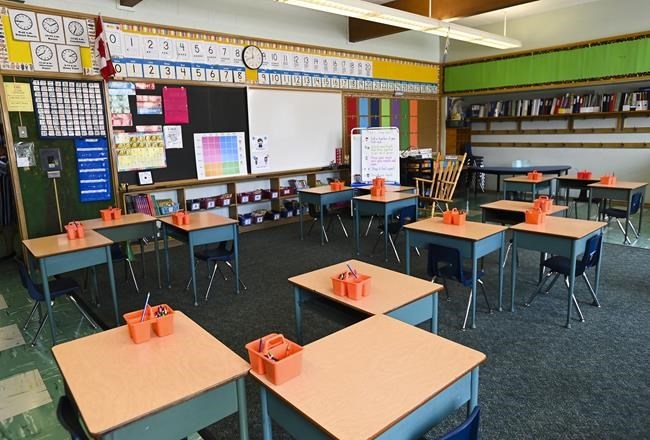TORONTO — As most Ontario students returned to classrooms Tuesday, a new report said students at schools in wealthier and urban neighbourhoods have greater access to extracurriculars like sports and clubs.
The report from advocacy group People for Education shows that while extracurricular activities have largely recovered from being paused during the COVID-19 pandemic, access is lagging behind for those in rural or low-income areas.
"During the pandemic we learned that there was this huge thing missing when kids couldn't go to school, and that had to do with relationships, the social aspects of school and all of these extracurricular activities ... being able to learn an instrument or going on field trips," said Annie Kidder, executive director of People for Education.
"They are a core part of a quality education," she said, pointing to research that shows extracurricular activities are where students develop lasting skills that will serve them in work or civic life, such as persistence, collaboration and complex problem solving.
Based on a survey of 1,044 principals across Ontario, it found 80 per cent of schools in high-income areas offered arts clubs and 44 per cent had an LGBTQ+ alliance last school year, compared to 66 per cent and 29 per cent of schools, respectively, in low-income areas.
Arts extracurriculars remained far below pre-pandemic levels in 2022/23, with 55 per cent of elementary and 74 per cent of high schools offering opportunities to learn an instrument during school hours. That's down from 84 per cent and 90 per cent respectively in 2019/20.
The differences are most clearly displayed when looking at "eco clubs," which 71 per cent of schools in high-income areas offered compared to 43 per cent in low-income areas.
The sole activity reported by a greater number of schools in low-income areas was breakfast or nutrition programs, which include meal gift cards, at 96 per cent compared to 53 per cent in high-income areas.
It's unclear if the gap in extracurricular offerings was widened by the pandemic, Kidder said, but the difference is at least clear to see now.
One factor that has changed significantly from pre-pandemic levels is school fundraising. The report highlights that there is no specific provincial funding to cover the costs of activities like arts, sports and clubs. That means schools often depend on fundraising to offset the costs associated with extracurriculars, such as equipment, she said.
Yet the report states that fundraising was at a 10-year low last school year, with many principals expressing sensitivity to financial hardships brought on by the pandemic. It also states that the average amount fundraised in high-income schools last year was almost three times higher than in low-income schools -- $10,423 compared to $3,757 per school.
Overload and burnout among teachers and school staff is also impacting extracurricular offerings, the report said, given they are often done voluntarily. Principals reported fewer staff having time and energy to dedicate to extracurriculars, in part because of staff shortages and increased needs in the classroom.
"They're concerned not only about their students' mental health, but about the mental health of their staff," said Kidder. "The sense that we got was it's hard to keep asking staff to do more on top of what they were already doing, on top of that level of stress in the system."
Kidder said People for Education is worried the province's "back to basics" education policy is squeezing out broader learning opportunities.
The report calls on the province to develop policy and funding that recognizes the established benefits of extracurricular activities and ensures equitable access. They'd also like to see a task force of experts, practitioners and students to inform those models.
"These are a vital element of education and by recognizing it in policy and in funding, then there could be funding available to boards who could ensure, hopefully, that there was more equitable access," said Kidder.
In a statement, Grace Lee, a spokesperson for Education Minister Stephen Lecce, said the government's top priority has been ensuring students return to school for a "normal, stable and enjoyable" school year -- which includes extracurriculars. She pointed to nearly $27 billion in public education investments and $700 million the year before, but did not respond to People for Education's specific recommendations.
"We know that extracurricular activities, sports, and field trips are an essential part of a quality education that builds real life and job skills," said Lee.
This report by The Canadian Press was first published Sept. 5, 2023.
Tyler Griffin, The Canadian Press

